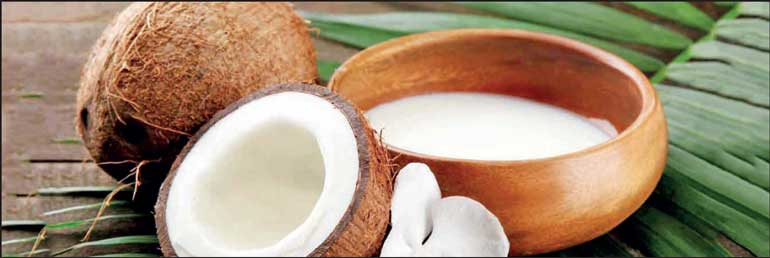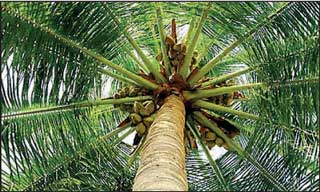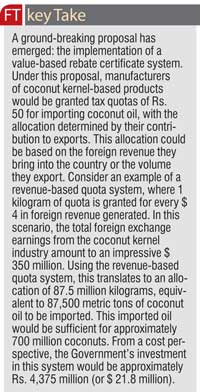Wednesday Apr 16, 2025
Wednesday Apr 16, 2025
Friday, 3 November 2023 00:00 - - {{hitsCtrl.values.hits}}

By Randeewa Malalasooriya

In recent times, Sri Lanka has been rethinking its approach to exports in response to global economic changes. It’s moving away from its traditional exports like tea and rubber and exploring new avenues to make the most of its rich agricultural resources.
Among the main agricultural exports, coconut is one such resource that has numerous opportunities. Coconuts, deeply ingrained in Sri Lanka’s agricultural heritage, are now at the forefront of this transformation. These versatile fruits play a vital role, contributing approximately 12% to the nation’s overall agricultural output.
Sri Lanka boasts an annual coconut crop of 2.8 to 3.2 billion nuts, according to CRI statistics. Yet, this abundance falls short of the annual requirement of 4.6 billion nuts, a demand driven by domestic consumption, coconut oil production, and exports.
Global recognition in the coconut industry
On the global stage, Sri Lanka has gained recognition in the coconut industry, primarily through products like Desiccated Coconut (DC) and brown fibre. The nation’s DC stands out with its distinct white colour and exquisite taste, securing Sri Lanka’s position as the fourth-largest exporter of kernel products worldwide. Additionally, Sri Lanka excels in brown fibre production,  known for its exceptionally long and pristine strands, making it the world’s leading exporter in this category, even finding applications in the brush industry.
known for its exceptionally long and pristine strands, making it the world’s leading exporter in this category, even finding applications in the brush industry.
However, the most remarkable aspect of this transformation is Sri Lanka’s shift from traditional exports to innovative and value-added coconut products. This transition underscores not only adaptability but also the immense potential that coconuts offer as a versatile and lucrative export commodity.
In an era where global preferences are shifting towards healthier, plant-based alternatives, coconut-based products, especially coconut milk, are experiencing an unprecedented surge in demand. Embracing this transformative wave allows Sri Lanka to maximise its abundant coconut resources and align perfectly with the evolving tastes and desires of global consumers.
The booming demand for coconut milk
In such a backdrop, the potential for export revenue from coconut milk is staggering. Sri Lanka could tap into international markets hungry for this creamy delight. Beyond its renown in culinary applications, Sri Lankan coconut milk, extracted by pressing grated fresh coconut kernel, has garnered global demand. It is available in various forms, including undiluted and diluted liquid versions, as well as skimmed and spray-dried powder forms.
The production of coconut skimmed milk, obtained through centrifugal separation to remove fat, provides a high-quality protein source, ideal for various food products. This aligns with current global trends, such as vegan, gluten-free, and soy-free foods, contributing to the surge in popularity of coconut milk as a dairy milk substitute. Sri Lanka has capitalised on this opportunity by manufacturing and exporting a wide range of flavoured and unflavoured drinking coconut milk to the world. Sri Lankan coconut milk stands out in the world market due to its distinct white hue, unique aroma, and delectable flavour.
Steady growth in export earnings
 The demand for coconut milk, with its diverse culinary applications and growing popularity in global cuisines, is on the rise. Export earnings from coconut milk have steadily climbed, providing a ray of hope in an otherwise challenging economic landscape.
The demand for coconut milk, with its diverse culinary applications and growing popularity in global cuisines, is on the rise. Export earnings from coconut milk have steadily climbed, providing a ray of hope in an otherwise challenging economic landscape.
Traditional methods of extracting coconut milk involve grating the coconut kernel and manually squeezing the fresh meat to yield the milk. However, this age-old practice results in significant economic loss, with only 30 to 40% of the coconut’s potential value being realised compared to industrial methods.
Comparing domestic and industrial milk extraction, the disparities become glaringly evident. While domestic usage recovers only 15 to 20% of the coconut’s fat content, industrial methods boast a more efficient 30 to 35% recovery rate. The residue from domestic extraction often goes to waste, whereas in industrial settings, it’s repurposed or sold. Even coconut water, shells, and pairings, which are discarded domestically, find productive use in industrial applications like activated carbon production and oil production.
Maximising coconut resources
Despite the shortfall of 1.4 to 1.6 billion coconuts, the nation still uses 1.8 billion coconuts domestically, primarily for culinary purposes. By reallocating a larger portion of this consumption for the production of industrial value-added products like coconut milk and coconut cream, Sri Lanka could harness its coconut resources more efficiently.
In 2019, Sri Lanka faced a local oil requirement of 140,000 metric tons, with a substantial portion being imported, equivalent to a staggering 840 million kilograms of coconuts, or roughly 1.4 billion nuts. This substantial coconut resource was harnessed to produce 240 million kilograms of coconut milk, valued at $ 480 million (approximately Rs. 91.2 billion).
This transformation from coconuts to coconut milk not only created a value addition of $ 126 million (around Rs. 24.5 billion) but also generated a net profit of Rs. 66.7 billion or $ 354 million. These statistics highlight the immense economic potential that Sri Lanka can unlock by maximising the use of its coconut resources, not only meeting local demands but also creating profitable opportunities through value addition.
To bolster Sri Lanka’s economy through its coconut kernel industry, a groundbreaking proposal has emerged: the implementation of a value-based rebate certificate system. Under this proposal, manufacturers of coconut kernel-based products would be granted tax quotas of Rs. 50 for importing coconut oil, with the allocation determined by their contribution to exports. This allocation could be based on the foreign revenue they bring into the country or the volume they export.
Consider an example of a revenue-based quota system, where 1 kilogram of quota is granted for every $ 4 in foreign revenue generated. In this scenario, the total foreign exchange earnings from the coconut kernel industry amount to an impressive $ 350 million. Using the revenue-based quota system, this translates to an allocation of 87.5 million kilograms, equivalent to 87,500 metric tons of coconut oil to be imported. This imported oil would be sufficient for approximately 700 million coconuts.
From a cost perspective, the Government’s investment in this system would be approximately Rs. 4,375 million (or $ 21.8 million). However, considering Sri Lanka’s existing coconut shortage for both domestic consumption and industrial usage, this strategy presents an innovative solution. It would alleviate the coconut shortage predicament and allow for the allocation of more coconuts to produce value-added coconut kernel products, consequently boosting the country’s foreign exchange reserves.
By producing coconut milk from the 700 million allocated coconuts, this initiative could generate foreign revenue of $ 280 million. After deducting the initial Government cost of $ 21.8 million, the net gain for the country would amount to $ 258.2 million. Simultaneously, the importation of fresh coconuts would bolster local coconut supplies, stabilising prices for both farmers and consumers.
The current expected foreign exchange revenue stands at an impressive $ 1.2 billion, with existing earnings from both kernel and non-kernel-based products at $ 400 million each. However, a critical $ 400 million deficit looms on the horizon.
To bridge this gap and secure a brighter future for Sri Lanka, the nation envisions importing fresh coconuts. These coconuts will be the raw materials for producing high-demand products like coconut milk, Virgin Coconut Oil (VCO), and Desiccated Coconut (DC). Each kilogram of coconut used in these processes promises significant foreign exchange gains, further enriching the nation’s coffers.
This visionary proposal doesn’t just reflect economic ambition; it reflects a deep commitment to safeguarding local coconut growers. When coconut prices at the Colombo auction dip below the threshold of Rs. 65 per nut, imports can be judiciously curtailed. This safeguard is more than a mere economic manoeuvre; it’s a lifeline for local growers, preserving their livelihoods and maintaining a fair minimum price for their produce.
Foremost among these advantages is the assurance of stable and improved income. Historically, coconut growers have grappled with the unpredictability of local coconut prices, which often fluctuate due to market dynamics. However, with the increase in coconut exports, demand for coconuts will rise, leading to higher and more stable prices for their produce. This means that coconut growers can look forward to a reliable source of income that not only sustains their livelihoods but elevates their economic well-being.
Coconut exports in the region: A lesson in economic growth
Coconut exports in the region have been a significant driver of economic growth and stability for several countries, including Sri Lanka. Neighbouring nations such as Thailand and Indonesia have successfully leveraged their natural coconut resources to establish themselves as major players in the global coconut market.
Thailand, for instance, has become a leading exporter of coconut products such as coconut milk, coconut water, and coconut oil. The country’s coconut milk, known for its quality and taste, has gained popularity in international markets and is widely used in various cuisines. Thailand’s success in coconut exports has contributed to its economic growth and stability.
Indonesia, another regional powerhouse in coconut production, has also diversified its coconut exports. The country is a major exporter of products like coconut oil and desiccated coconut. Indonesia’s coconut oil, in particular, is in high demand globally, with applications in food, cosmetics, and industrial sectors.
These neighbouring countries have not only bolstered their economies through coconut exports but have also made pragmatic choices like importing coconuts for domestic consumption. This strategic approach allows them to focus on producing high-value coconut-based products for the global market.
Coconut exports in the region, led by countries like Thailand and Indonesia, have demonstrated the economic potential of coconut-based products in the global market. Sri Lanka is following suit by diversifying its coconut exports, aligning with contemporary consumer preferences and global trends, and aiming for economic growth and sustainability.
Sri Lanka, recognising the success of its regional counterparts, is also shifting its focus towards coconut-based exports, particularly coconut milk. This shift reflects a broader change in mindset, emphasising adaptability and pragmatism. By learning from its neighbours and maximising the potential of coconut exports, Sri Lanka aims to unlock a future where coconuts are not wasted but celebrated as a valuable export commodity.
Promoting sustainable agriculture and economic prosperity
Furthermore, the expansion of coconut exports safeguards the future of these farming communities. By creating a more lucrative market for coconuts, this initiative encourages the younger generation to embrace coconut farming as a viable profession. This not only preserves the traditional knowledge and practices of coconut cultivation but also injects fresh energy into the industry, ensuring its continuity for generations to come.
The ripple effects of this growth extend beyond financial gains. With increased income and market stability, coconut growers can invest in the modernisation of their farms, adopting advanced farming techniques and technologies. This not only enhances productivity but also promotes sustainable and eco-friendly farming practices, aligning with global demands for responsible agriculture.
These countries’ success in coconut milk exports reflects the increasing popularity of coconut-based products, driven by global trends favouring healthier and plant-based food alternatives. As consumers worldwide continue to seek coconut milk for its culinary and health benefits, the region’s coconut-producing nations are poised to play a crucial role in meeting this demand and expanding their export markets further. Coconut milk exports are not only economically beneficial but also align with the shift towards sustainable and plant-based food options, making them a significant part of the region’s agricultural exports.
Exporting coconut milk holds significant economic advantages for Sri Lanka. This strategic shift from traditional exports like tea and rubber diversifies the country’s export portfolio, reducing reliance on a few commodities and spreading economic risk. The global demand for coconut milk is on the rise, thanks to its versatile use in various cuisines and as a dairy milk substitute, providing Sri Lanka with an opportunity to tap into a lucrative market.
Moreover, processing coconut milk adds value to raw coconuts, enabling higher pricing and profit margins. This value addition contributes to increased revenue, strengthens foreign exchange reserves, and fosters job creation along the coconut milk production chain. Importantly, it stabilises coconut prices for farmers and consumers, ensuring fair returns for agricultural efforts. By adapting to global food trends favouring healthier and plant-based options, Sri Lanka’s coconut milk exports not only boost the economy but also promote sustainability in the country’s rich coconut industry.
Sri Lanka’s journey towards coconut-based exports, especially coconut milk, is a transformative and forward-thinking approach that capitalises on the nation’s abundant coconut resources. It offers economic growth, stability, and sustainability while preserving the cultural and agricultural heritage of coconut farming. This strategic shift holds the promise of a brighter future for Sri Lanka, where coconuts are not just a local tradition but a global export commodity driving prosperity and well-being.
(The writer is President of the Coconut Milk Manufacturers Association.)
Discover Kapruka, the leading online shopping platform in Sri Lanka, where you can conveniently send Gifts and Flowers to your loved ones for any event including Valentine ’s Day. Explore a wide range of popular Shopping Categories on Kapruka, including Toys, Groceries, Electronics, Birthday Cakes, Fruits, Chocolates, Flower Bouquets, Clothing, Watches, Lingerie, Gift Sets and Jewellery. Also if you’re interested in selling with Kapruka, Partner Central by Kapruka is the best solution to start with. Moreover, through Kapruka Global Shop, you can also enjoy the convenience of purchasing products from renowned platforms like Amazon and eBay and have them delivered to Sri Lanka.
Discover Kapruka, the leading online shopping platform in Sri Lanka, where you can conveniently send Gifts and Flowers to your loved ones for any event including Valentine ’s Day. Explore a wide range of popular Shopping Categories on Kapruka, including Toys, Groceries, Electronics, Birthday Cakes, Fruits, Chocolates, Flower Bouquets, Clothing, Watches, Lingerie, Gift Sets and Jewellery. Also if you’re interested in selling with Kapruka, Partner Central by Kapruka is the best solution to start with. Moreover, through Kapruka Global Shop, you can also enjoy the convenience of purchasing products from renowned platforms like Amazon and eBay and have them delivered to Sri Lanka.